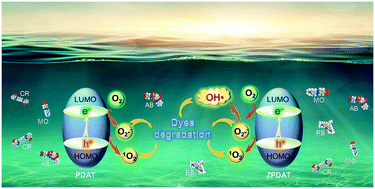Efficient organic pollutant degradation under visible-light using functional polymers of intrinsic microporosity†
Abstract
Organic photocatalysts have recently drawn intense attention to wastewater treatment through the efficient utilization of solar energy. Rational design and synthesis of organic photocatalysts with facilitated charge-carrier transfer are crucial for achieving high-performance photodegradation of pollutants. In this work, functional polymers of intrinsic microporosity (PIMs) were synthesized by a quaternization reaction, and the zwitterionic and D–π–A structured polymers show visible-light-driven catalytic activity for the degradation of organic pollutants. The formation of D–π–A structures in PIMs is demonstrated to extend visible-light absorption and promote charge-transfer transition. Besides, the zwitterionic structures improve hydrophilicity and induce the aggregation of polymer chains, facilitating charge-carrier diffusion at the polymer–water and polymer–polymer interfaces. The combination of these favorable features endows the resulting PIMs with high catalytic degradation ability toward organic dyes under visible-light irradiation, which prevails over state-of-the-art organic photocatalysts.



 Please wait while we load your content...
Please wait while we load your content...